A Guided Wave Sensor Enabling Simultaneous Wavenumber-Frequency Analysis for Both Lamb and Shear-Horizontal Waves
Abstract
:1. Introduction
2. Piezoelectric Modeling
3. Numerical Simulation
3.1. Sensitivity to Guided Wave Modes
3.2. Width Selection
4. Sensor Design and Fabrication
5. Experiments
5.1. Sensitivity to Lamb Waves
5.2. Sensitivity to Shear Horizontal Waves
5.3. Multi-Mode Reception and Decomposition
6. Conclusions
Acknowledgments
Author Contributions
Conflicts of Interest
References
- Staszewski, W.J.; Mahzan, S.; Traynor, R. Health monitoring of aerospace composite structures—Active and passive approach. Compos. Sci. Technol. 2009, 69, 1678–1685. [Google Scholar] [CrossRef]
- Rose, J.L. Ultrasonic Guided Waves in Solid Media; Cambridge University Press: Cambridge, MA, USA, 2014. [Google Scholar]
- Alleyne, D.N.; Cawley, P. The interaction of lamb waves with defects. IEEE Trans. Ultrason. Ferroelectr. Freq. Control 1992, 39, 381–397. [Google Scholar] [CrossRef] [PubMed]
- Castaings, M.; Le Clezio, E.; Hosten, B. Modal decomposition method for modeling the interaction of lamb waves with cracks. J. Acoust. Soc. Am. 2002, 112, 2567–2582. [Google Scholar] [CrossRef] [PubMed]
- Rajagopal, P.; Lowe, M.J.S. Short range scattering of the fundamental shear horizontal guided wave mode normally incident at a through-thickness crack in an isotropic plate. J. Acoust. Soc. Am. 2007, 122, 1527–1538. [Google Scholar] [CrossRef] [PubMed]
- Ratassepp, M.; Lowe, M.J.S.; Cawley, P.; Klauson, A. Scattering of the fundamental shear horizontal mode in a plate when incident at a through crack aligned in the propagation direction of the mode. J. Acoust. Soc. Am. 2008, 124, 2873–2882. [Google Scholar] [CrossRef] [PubMed]
- Ihn, J.-B.; Chang, F.-K. Detection and monitoring of hidden fatigue crack growth using a built-in piezoelectric sensor/actuator network: I. Diagnostics. Smart Mater. Struct. 2004, 13, 609. [Google Scholar] [CrossRef]
- Giurgiutiu, V.; Zagrai, A.; Bao, J.J. Piezoelectric wafer embedded active sensors for aging aircraft structural health monitoring. Struct. Health Monit. 2002, 1, 41–61. [Google Scholar] [CrossRef]
- Salas, K.I.; Cesnik, C.E.S. Design and characterization of the clover transducer for structural health monitoring. In Proceedings of the Health Monitoring of Structural and Biological Systems 2008, San Diego, CA, USA, 10–13 March 2008.
- Rose, J.L.; Pelts, S.P.; Quarry, M.J. A comb transducer model for guided wave nde. Ultrasonics 1998, 36, 163–169. [Google Scholar] [CrossRef]
- Zhu, W.; Rose, J.L. Lamb wave generation and reception with time-delay periodic linear arrays: A bem simulation and experimental study. IEEE Trans. Ultrason. Ferroelectr. Freq. Control 1999, 46, 654–664. [Google Scholar] [PubMed]
- Yu, L.; Giurgiutiu, V. In situ 2-D piezoelectric wafer active sensors arrays for guided wave damage detection. Ultrasonics 2008, 48, 117–134. [Google Scholar] [CrossRef] [PubMed]
- Kamal, A.; Giurgiutiu, V. Shear horizontal wave excitation and reception with shear horizontal piezoelectric wafer active sensor (SH-PWAS). Smart Mater. Struct. 2014, 23, 085019. [Google Scholar] [CrossRef]
- Zhou, W.; Li, H.; Yuan, F.-G. Fundamental understanding of wave generation and reception using d36 type piezoelectric transducers. Ultrasonics 2015, 57, 135–143. [Google Scholar] [CrossRef] [PubMed]
- Miao, H.; Li, F. Realization of face-shear piezoelectric coefficient d36 in PZT ceramics via ferroelastic domain engineering. Appl. Phys. Lett. 2015, 107. [Google Scholar] [CrossRef]
- Köhler, B.; Gaul, T.; Lieske, U.; Schubert, F. Shear horizontal piezoelectric fiber patch transducers (SH-PFP) for guided elastic wave applications. NDT E Int. 2016, 82, 1–12. [Google Scholar] [CrossRef]
- Bulletti, A.; Giannelli, P.; Calzolai, M.; Capineri, L. An integrated acousto/ultrasonic structural health monitoring system for composite pressure vessels. IEEE Trans. Ultrason. Ferroelectr. Freq. Control 2016, 63, 864–873. [Google Scholar] [CrossRef] [PubMed]
- Wilcox, P.; Monkhouse, R.; Lowe, M.; Cawley, P. The use of huygens’ principle to model the acoustic field from interdigital lamb wave transducers. In Review of Progress in Quantitative Nondestructive Evaluation, Volume 17a; Thompson, D.O., Chimenti, D.E., Eds.; Springer: Boston, MA, USA, 1998; pp. 915–922. [Google Scholar]
- Hay, T.R.; Rose, J.L. Flexible pvdf comb transducers for excitation of axisymmetric guided waves in pipe. Sens. Actuators A Phys. 2002, 100, 18–23. [Google Scholar] [CrossRef]
- Bent, A.A.; Hagood, N.W. Piezoelectric fiber composites with interdigitated electrodes. J. Intell. Mater. Syst. Struct. 1997, 8, 903–919. [Google Scholar] [CrossRef]
- Matt, H.M.; di Scalea, F.L. Macro-fiber composite piezoelectric rosettes for acoustic source location in complex structures. Smart Mate. Struct. 2007, 16, 1489. [Google Scholar] [CrossRef]
- Stepinski, T.; Mańka, M.; Martowicz, A. Interdigital lamb wave transducers for applications in structural health monitoring. NDT E Int. 2017, 86, 199–210. [Google Scholar] [CrossRef]
- Ren, B.; Lissenden, C.J. PVDF multielement lamb wave sensor for structural health monitoring. IEEE Trans. Ultrason. Ferroelectr. Freq. Control 2016, 63, 178–185. [Google Scholar] [CrossRef] [PubMed]
- Ren, B.; Lissenden, C.J. Modal content-based damage indicators for disbonds in adhesively bonded composite structures. Struct. Health Monit. 2016. [Google Scholar] [CrossRef]
- Measurement Specialties Inc. Piezo Film Sensors Technical Manual. Available online: https://www.sparkfun.com/datasheets/Sensors/Flex/MSI-techman.pdf (accessed on 28 February 2017).
- Faust, D.; Lakes, R. Temperature and substrate dependence of piezoelectric sensitivity for PVDF films. Ferroelectrics 2015, 481, 1–9. [Google Scholar] [CrossRef]
- Auld, B.A. Acoustic Fields and Waves in Solids; Krieger Publishing Company: Malabar, FL, USA, 1990. [Google Scholar]
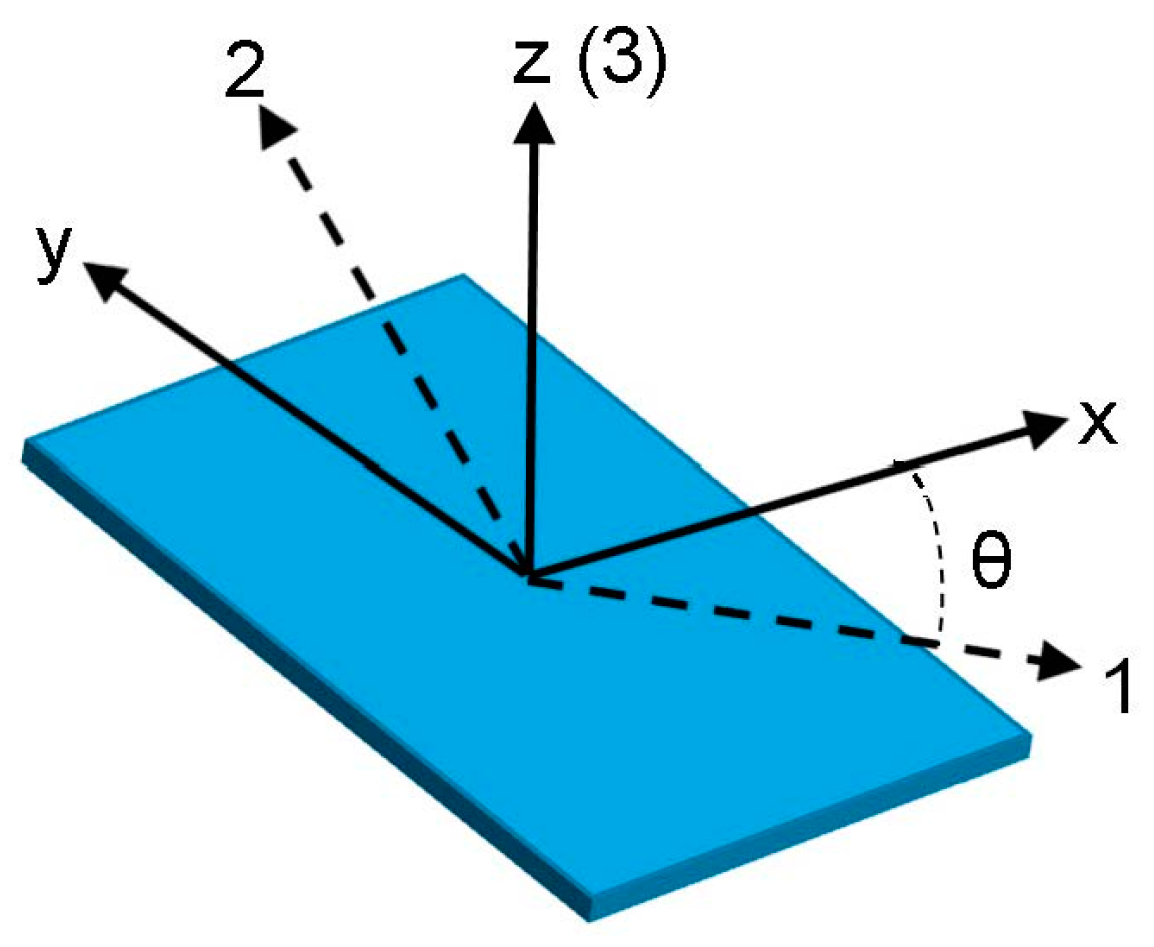
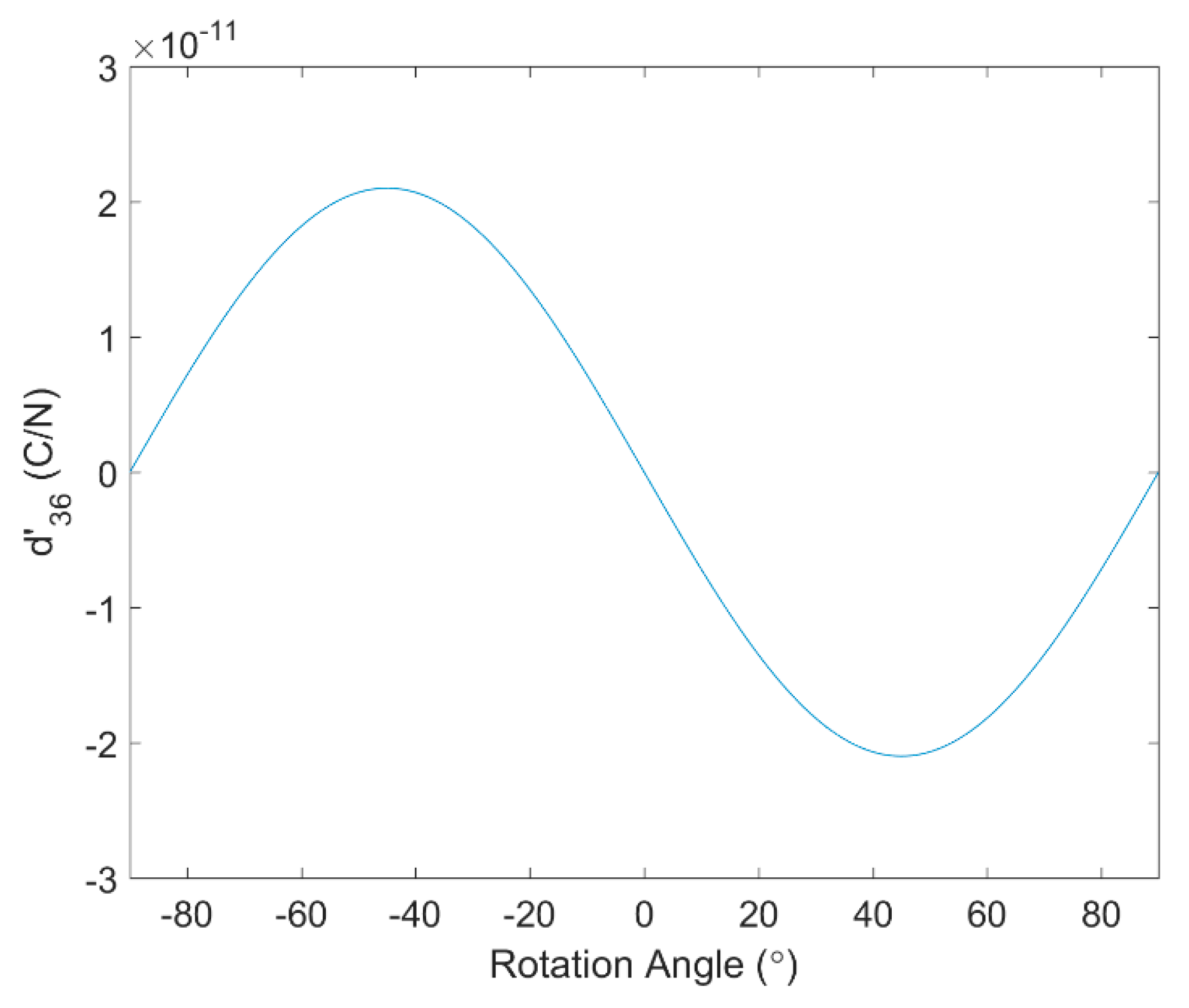
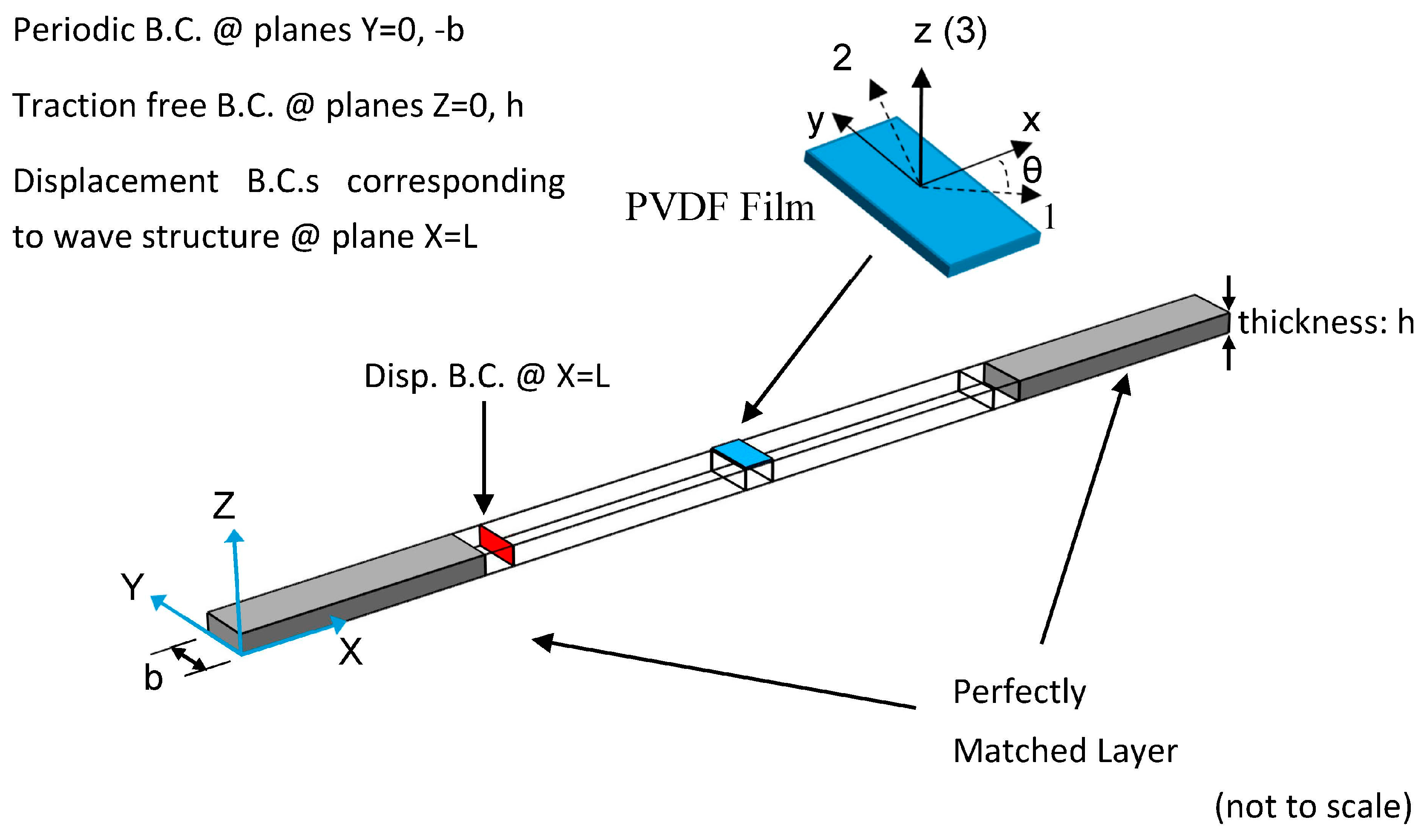
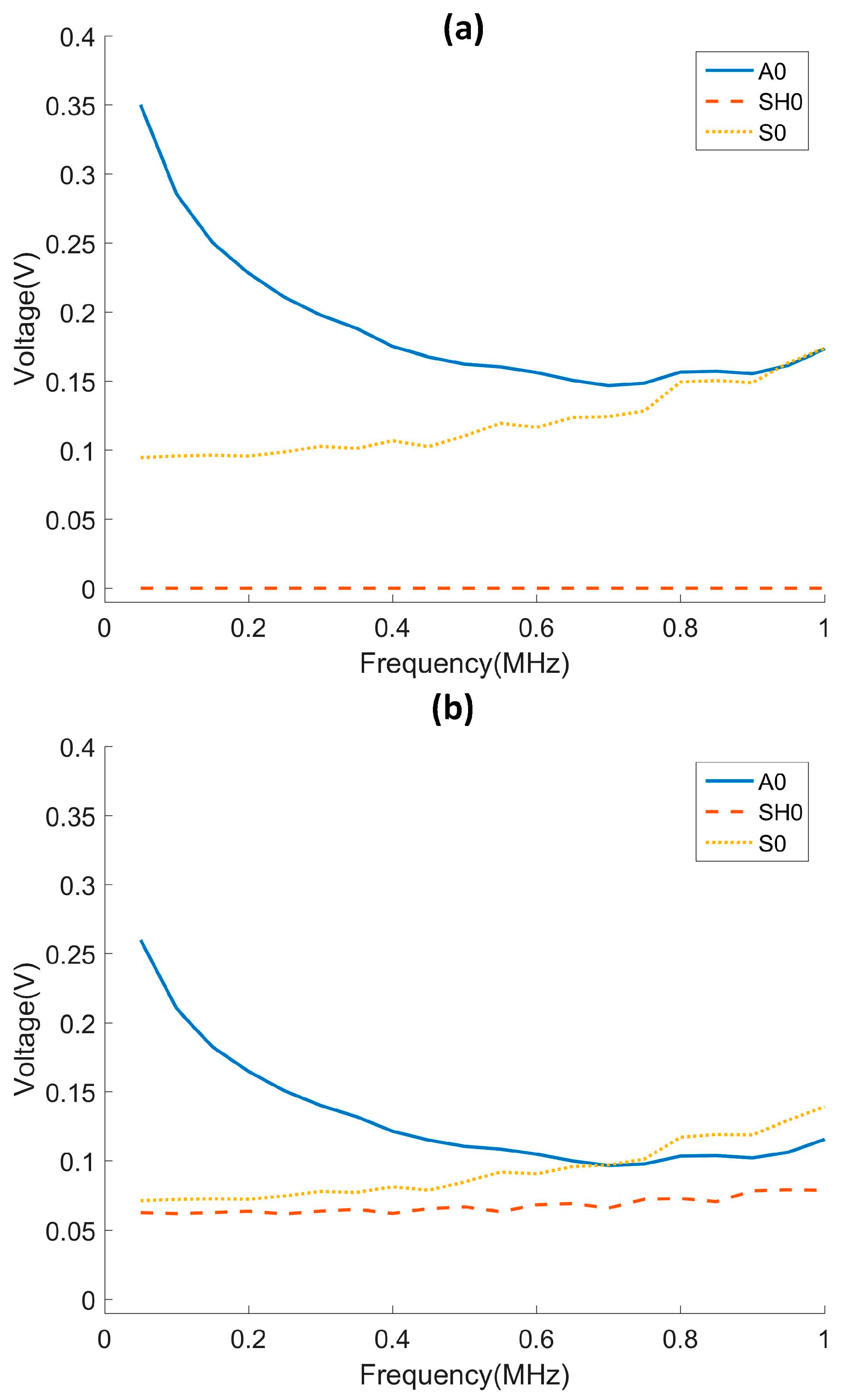
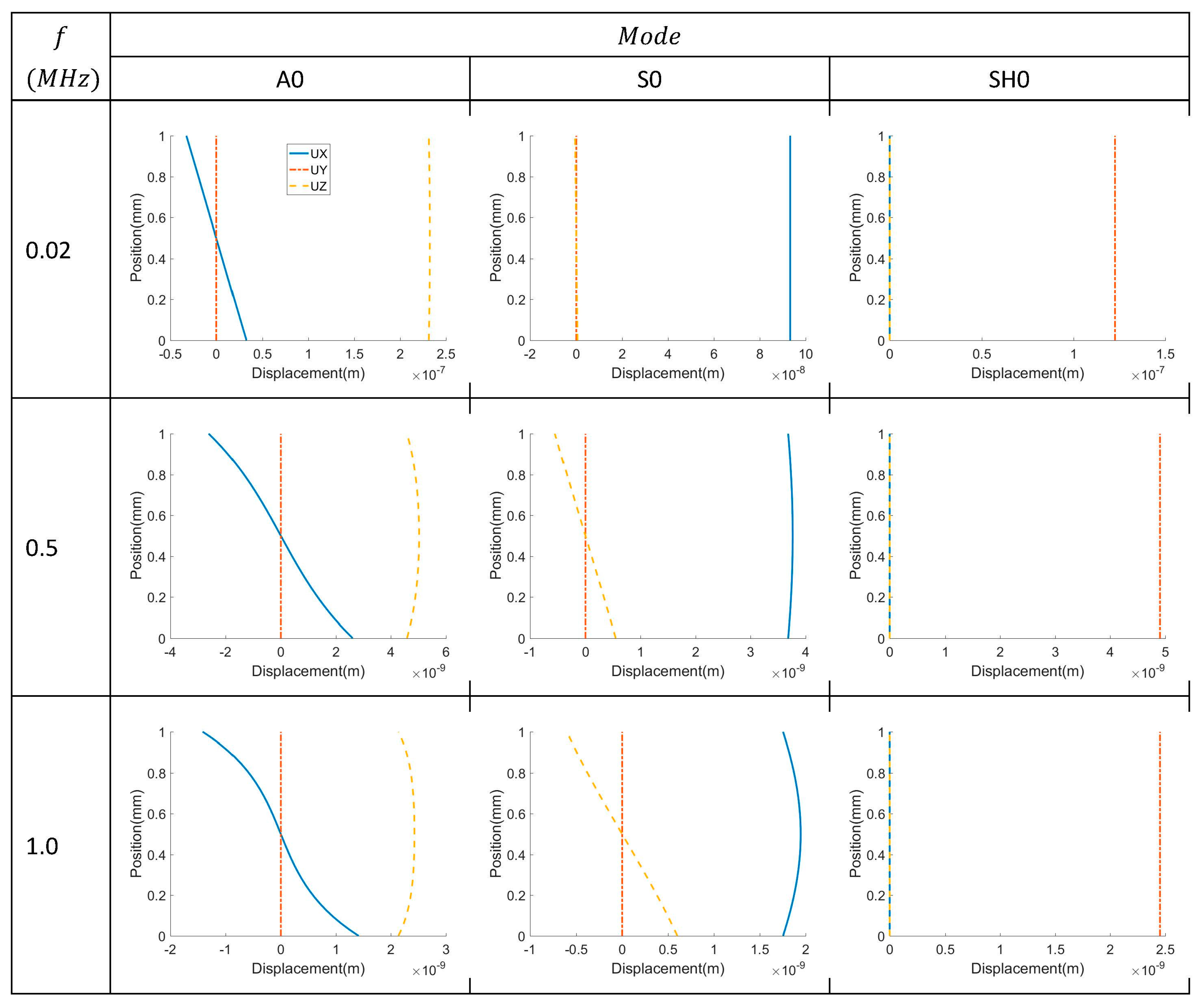




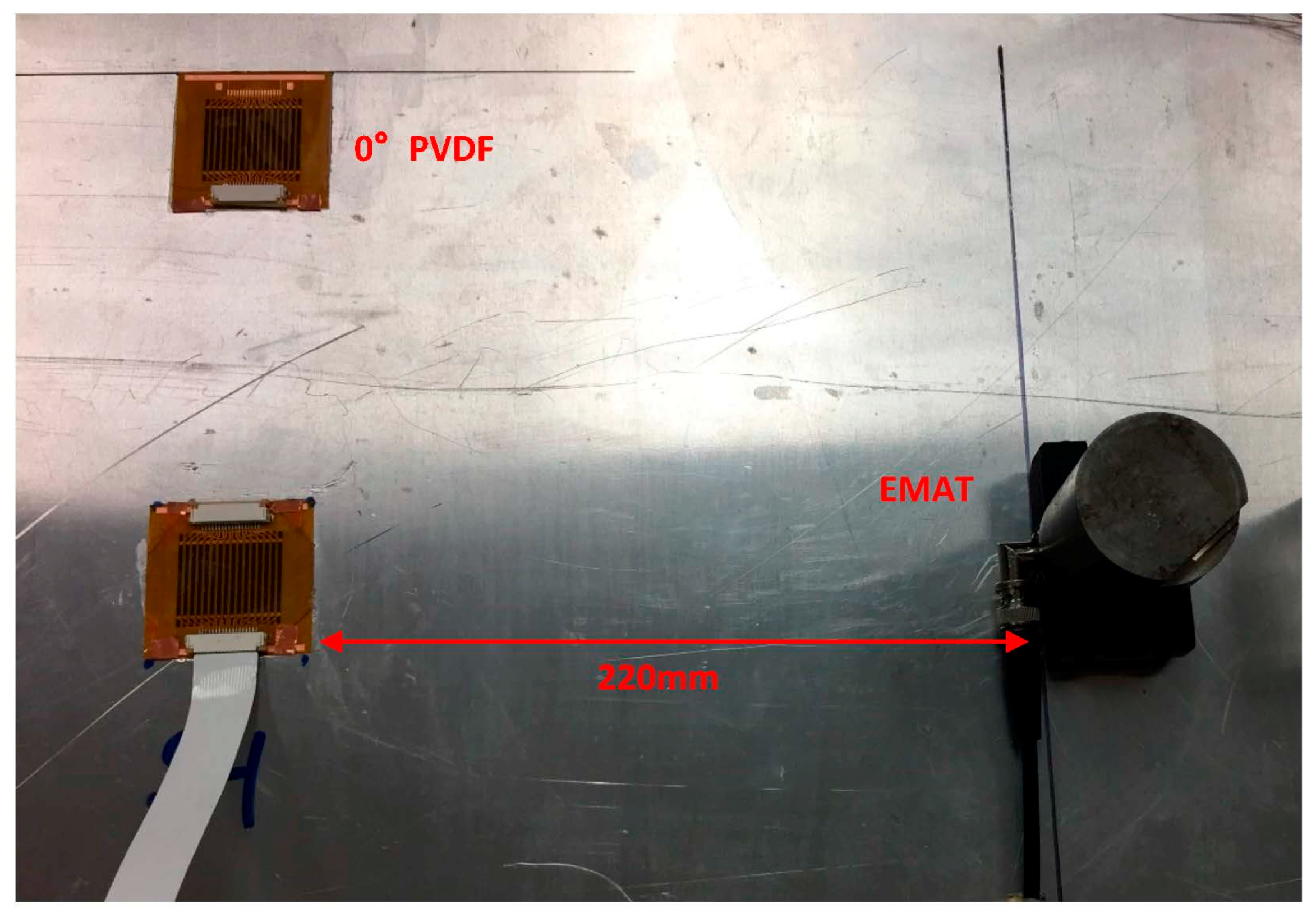
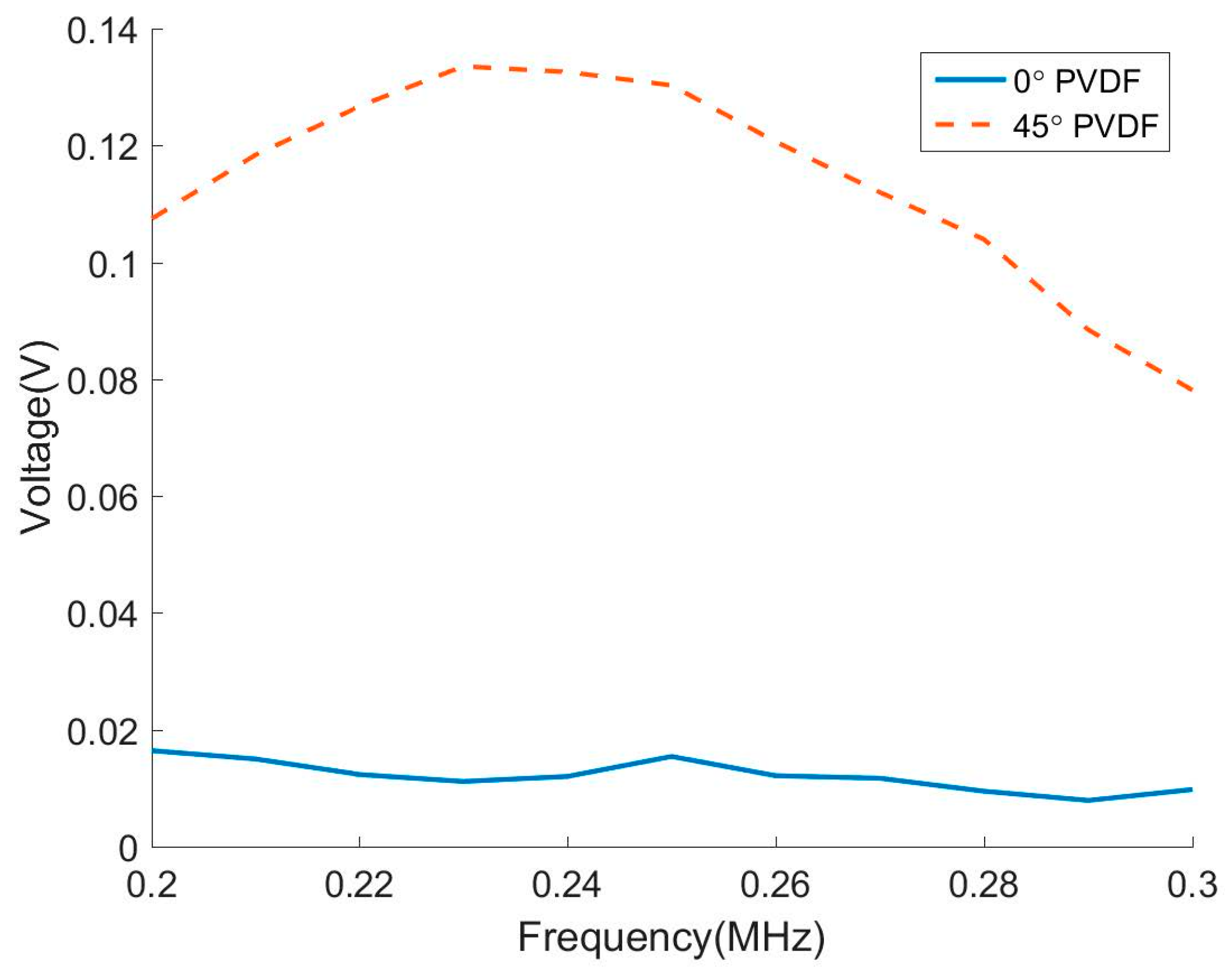
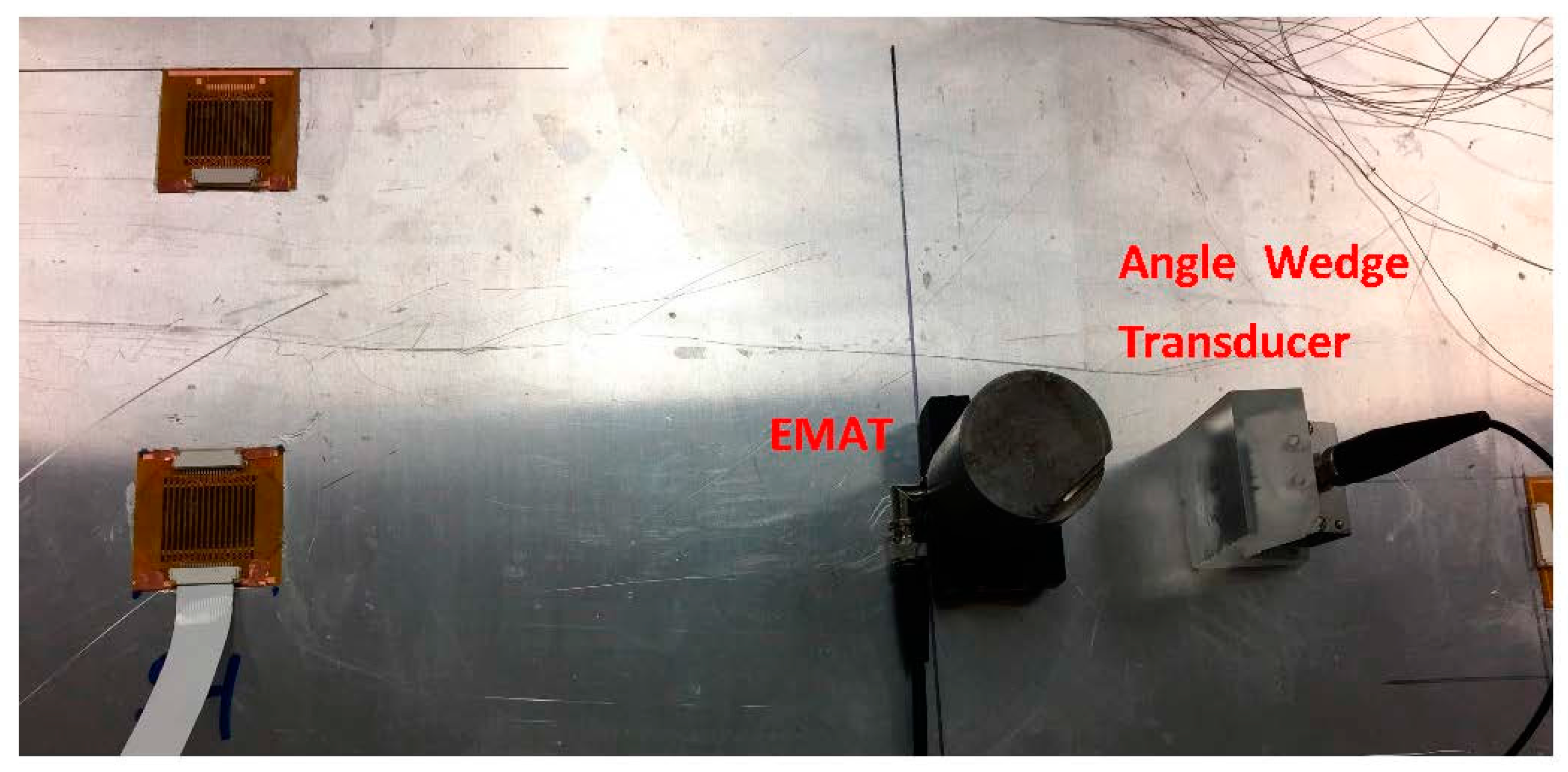
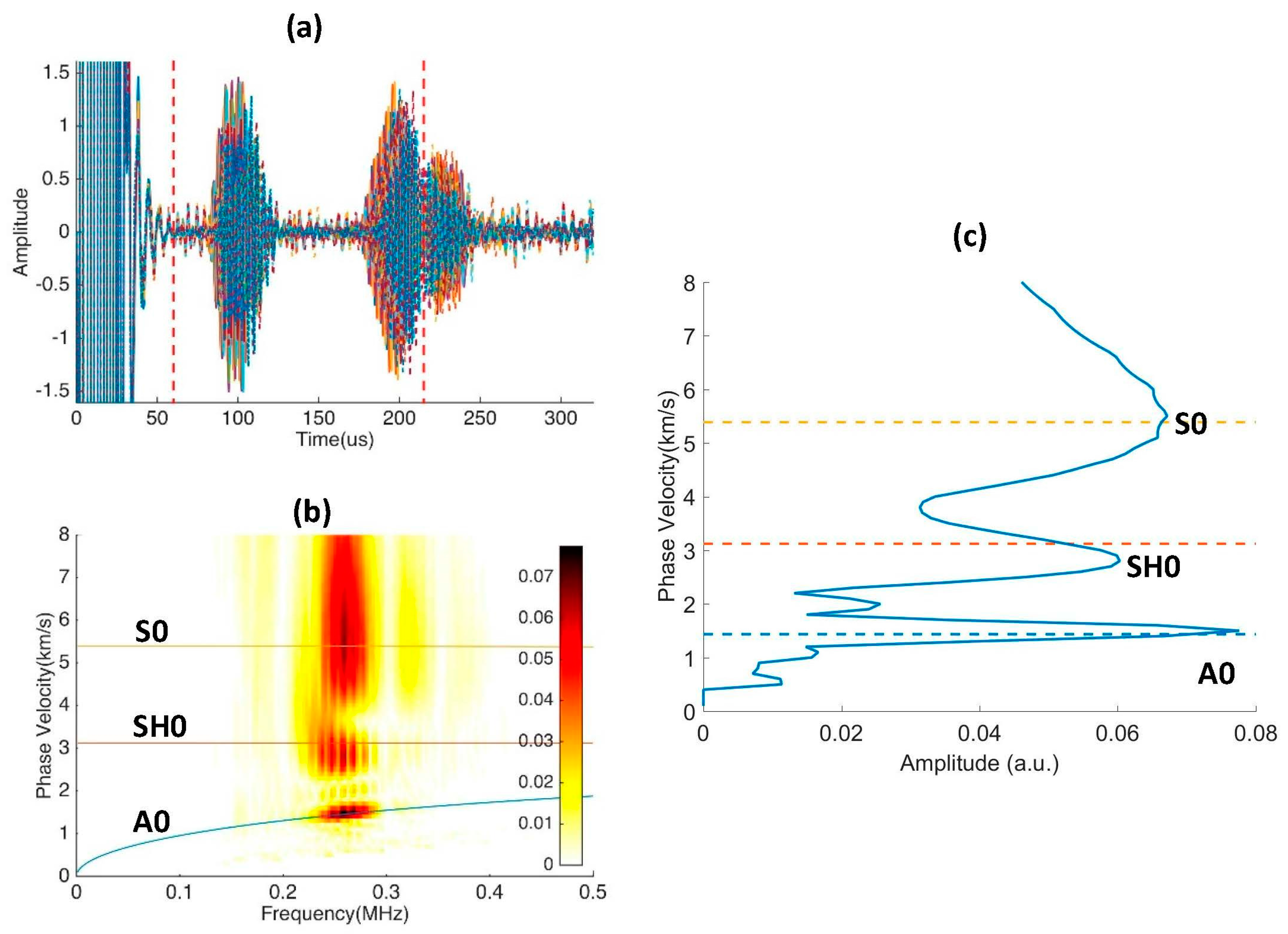
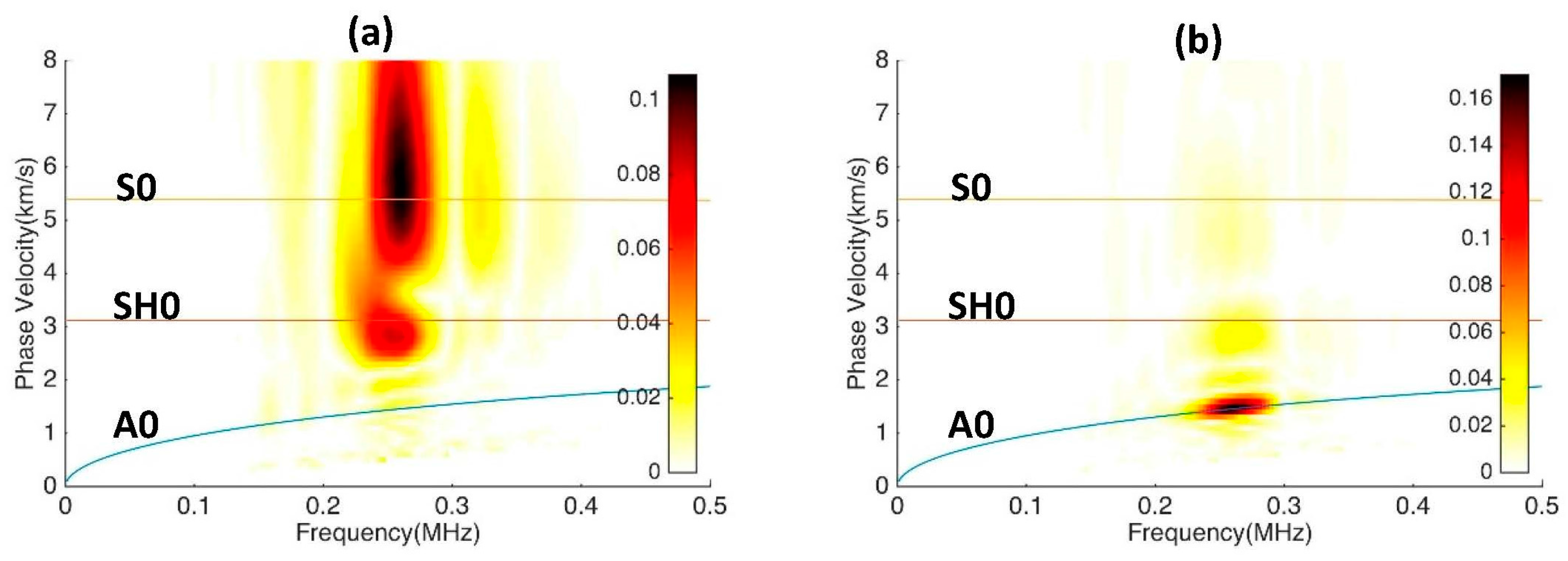
| Symbol | Description | Value | Units |
|---|---|---|---|
| Mass density | 1780 | ||
| Young’s modulus | 3 | ||
| Poisson’s ratio | 0.4 | - | |
| Piezo Strain constants | 23 | ||
| 2 | |||
| −33 | |||
| Permittivity | 106 |
© 2017 by the authors. Licensee MDPI, Basel, Switzerland. This article is an open access article distributed under the terms and conditions of the Creative Commons Attribution (CC BY) license ( http://creativecommons.org/licenses/by/4.0/).
Share and Cite
Ren, B.; Cho, H.; Lissenden, C.J. A Guided Wave Sensor Enabling Simultaneous Wavenumber-Frequency Analysis for Both Lamb and Shear-Horizontal Waves. Sensors 2017, 17, 488. https://doi.org/10.3390/s17030488
Ren B, Cho H, Lissenden CJ. A Guided Wave Sensor Enabling Simultaneous Wavenumber-Frequency Analysis for Both Lamb and Shear-Horizontal Waves. Sensors. 2017; 17(3):488. https://doi.org/10.3390/s17030488
Chicago/Turabian StyleRen, Baiyang, Hwanjeong Cho, and Cliff J. Lissenden. 2017. "A Guided Wave Sensor Enabling Simultaneous Wavenumber-Frequency Analysis for Both Lamb and Shear-Horizontal Waves" Sensors 17, no. 3: 488. https://doi.org/10.3390/s17030488
APA StyleRen, B., Cho, H., & Lissenden, C. J. (2017). A Guided Wave Sensor Enabling Simultaneous Wavenumber-Frequency Analysis for Both Lamb and Shear-Horizontal Waves. Sensors, 17(3), 488. https://doi.org/10.3390/s17030488






